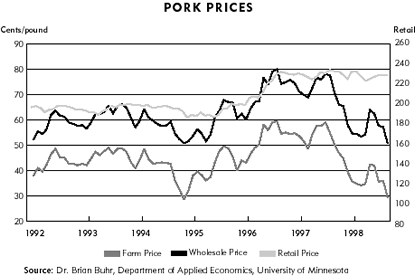In the last year, the price farmers get for hogs has declined by over 60 percent while retail prices for pork dropped 2 percent or so. Most producers are outraged by this discrepancy. They and many consumers assume that if farmgate prices drop a given amount then retail prices should drop identically, either in percentage terms or in cents per pound. If this does not happen, they assume that price gouging is occurring somewhere.
In reality, things are not quite as simple. A decrease in farm level prices does not affect the cost of transporting either live hogs or meat, nor that of slaughtering, cutting, processing, warehousing or retailing. So there is no reason why a farm price decline should reduce consumer prices by exactly the same percentage.
The argument that retail prices should decline by the same number of cents per pound is a stronger one. In fact, the effective cost per pound of useable meat to the packer declines by a larger absolute number of cents per pound than does the liveweight. If live hogs cost $50 per hundredweight or 50 cents per pound, and the useable dressed carcass is 66 percent of the liveweight, then each pound of carcass costs about 75 cents. At 30 cents per pound liveweight and the same dressing percentage, the carcass cost is about 45 cents. Equal percentage drops, 40 percent in this case, in both live and carcass weight prices translate into a 10 cents greater drop per pound on a carcass basis.
This of course ignores the packer's slaughtering cost and the amount received by the packer for "variety meats" and "offal"—those parts of the live hog such as organs, hide, snouts, ears, and so on, that have some commercial value but which are not included in the carcass weight. The packers' slaughtering costs are unaffected by price fluctuations at the farm or meat counter level. And the value of offal drops, just as the carcass does, when supply increases. So as farm prices drop by 30 cents or more as we have seen in the past 12 months, the argument goes, retail prices should drop by at least that amount and perhaps as much as 45 cents, even if the percentage decrease at farm and retail levels is not the same. A 30 cents or 45 cents decrease would be substantially greater than the 2 percent average retail price drop seen so far.
Not so fast, packers would respond. Slaughter costs do not necessarily change with farm or retail prices. But they do change when slaughter plants are pushed to the limits of capacity. That is clearly going on at present. Hog packing has been going through some of the same structural changes as beef packing over the past decade, with new plants built, at times in very new locations, and older plants closed as they find they cannot compete with newer, more efficient facilities. The U.S. Department of Agriculture estimates that the nation's hog slaughter capacity declined by 37,000 head per day over the last year. In October and November 1998, over 2 million hogs were being slaughtered per week in the remaining plants. That requires running operations 16 or 24 hours per day, six days per week and paying overtime, which in a labor-intensive industry such as meat packing, drives up the average cost of slaughtering.
The decline in slaughter capacity combined with significant expansion in hog production capacity in the last decade has resulted in very illiquid markets in many areas. Once all the packing plants in a given geographic area are running at full capacity, they do not buy more hogs at any price. Prices for the remaining hogs offered by producers then drop precipitously, not in small marginal increments. It is just like the situation on stock exchanges when panic selling occurs and the number of sellers temporarily overwhelms the number of buyers. Industry analysts point out that the extremely low prices reported in the press, including some in the mid $14/hundredweight range, did not apply to all hogs slaughtered that day. These prices were paid only for the last few hogs sold that day, the "marginal" ones in economists' lingo, after the packers bought enough to meet their plants' capacity.

Moreover, while farmers usually focus on meat packers as the most visible "middlemen" with whom they deal, there are other players in moving pork from farm to table. In the last few years, there is considerable evidence that wholesale prices have followed farm level prices quite closely. It is the spread between wholesale and retail prices that has widened. (See chart.) If farmers are angry, packers say, they should direct it at supermarkets and other meat retailers who have not dropped their prices in line with reduction in wholesale prices.
Retailers respond that the numbers are bad, that USDA retail price series do not adequately take into account large quantities of pork that are sold at heavy discounts. Furthermore, they argue, they are just making up for narrow margins they experienced two years ago, when farm and wholesale prices were higher.
The use of posted regular prices rather than "specials" has always been a knotty one in compiling price indices, especially when structural change occurs in a retail sector. But it seems clear to many economists that while USDA price series are not perfect, unmeasured heavy discounting cannot account for all of the widening wholesale-retail spread. And they point out that retailers' margins were not terribly tight in the past as some maintain.
Like other facets of the current problems in the pork sector, the question of why players at different levels get different shares may long be a matter of contentious dispute among farmers and the meat trade. It will provide fallow ground for Ph.D. candidates to research. And don't be surprised to see news reports of farmers protesting outside supermarkets.
Related articles, fedgazette, April 1996: |





